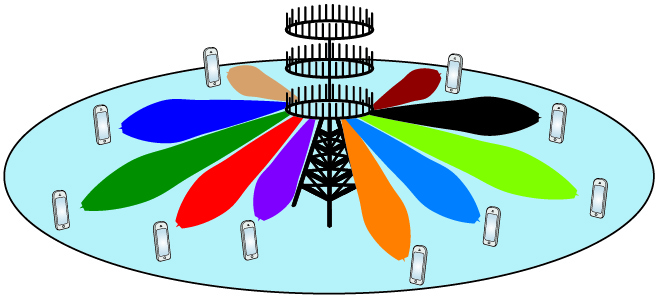Sidan finns bara på engelska
TSKS14 Multi-antenna communication
TSKS14 Multi-antenna Communication is a course that teaches the fundamentals of multi-antenna communication, which is one of the key technologies in future generation wireless communication systems, such as 5G. Linköping University has world-leading research in this area and this course is based on the book “Fundamentals of Massive MIMO” written by LIU researchers in collaboration with experts at Bell Labs in New Jersey.

The course is given in English and the detailed course information is therefore in English.
The course starts from the channel capacity formulation for additive white Gaussian noise (AWGN) channels, which you hopefully have seen in a basic course on communications. The capacity formula is analyzed and then generalized to channels with multiple antennas, at either the transmitter or the receiver, or both. The concepts of spatial multiplexing and array gain are described for such channels, which show the great improvements in communication performance that multiple antenna channels offer. Next, we consider how variations in the channel conditions, known as channel fading, affect the capacity. We introduce the concepts of outage capacity, spatial diversity, and ergodic capacity.
The last two-thirds of the course deals with multi-user communications, where a base station equipped with multiple antennas simultaneously transmits/receives information signals to/from multiple users. This is achieved by exploiting the spatial domain to separate the users by beamforming and this is a key technology for 5G communications. Fundamental properties such as channel coherence intervals, channel estimation, uplink detection, downlink beamforming, power control, and interference management are covered in the course. One important example of multi-user communications is Massive MIMO (multiple-input multiple-output), where the base station is equipped with hundreds of antennas to separate the users particularly well spatially and at the same time simplify the signal processing and the analysis.
The analysis of multiple antenna communication systems builds on communication theory (the channel capacity concept), linear algebra (due to the multiple antennas), and mathematical statistics (due to the channel variations).
Lecture Content
- Motivation for Multiple Antenna Communications
- Basics of Transmit and Receive Beamforming
- Fading Channels and Related Capacity Concepts
- Capacity of Point-to-Point MIMO Channels
- Introduction to Multiuser MIMO
- Uplink Multiuser MIMO and Channel Acquisition
- Multiuser MIMO With Optimal Linear Detection
- Favorable Propagation and MR Processing
- Downlink massive MIMO
- Massive MIMO in cellular networks
- Power Control for Max-Min Fairness
Instructors
- Course director and lecturer: Zheng Chen
- Assistants: Zakir Hussain Shaik
Course material
-
[Björnson2021] Emil Björnson, “Introduction to Multiple Antenna Communications”, version from 2021. A PDF of this compendium can be downloaded in the course room.
-
[Marzetta2016] Thomas L. Marzetta, Erik G. Larsson, Hong Yang, Hien Quoc Ngo, “Fundamentals of Massive MIMO,” Cambridge University Press, 2016.
Prerequisites
- Linear algebra, probability theory, and general mathematical maturity.
- Programming skills.
Information for enrolled students
For detailed lecture, tutorial and lab plans, see the course room in